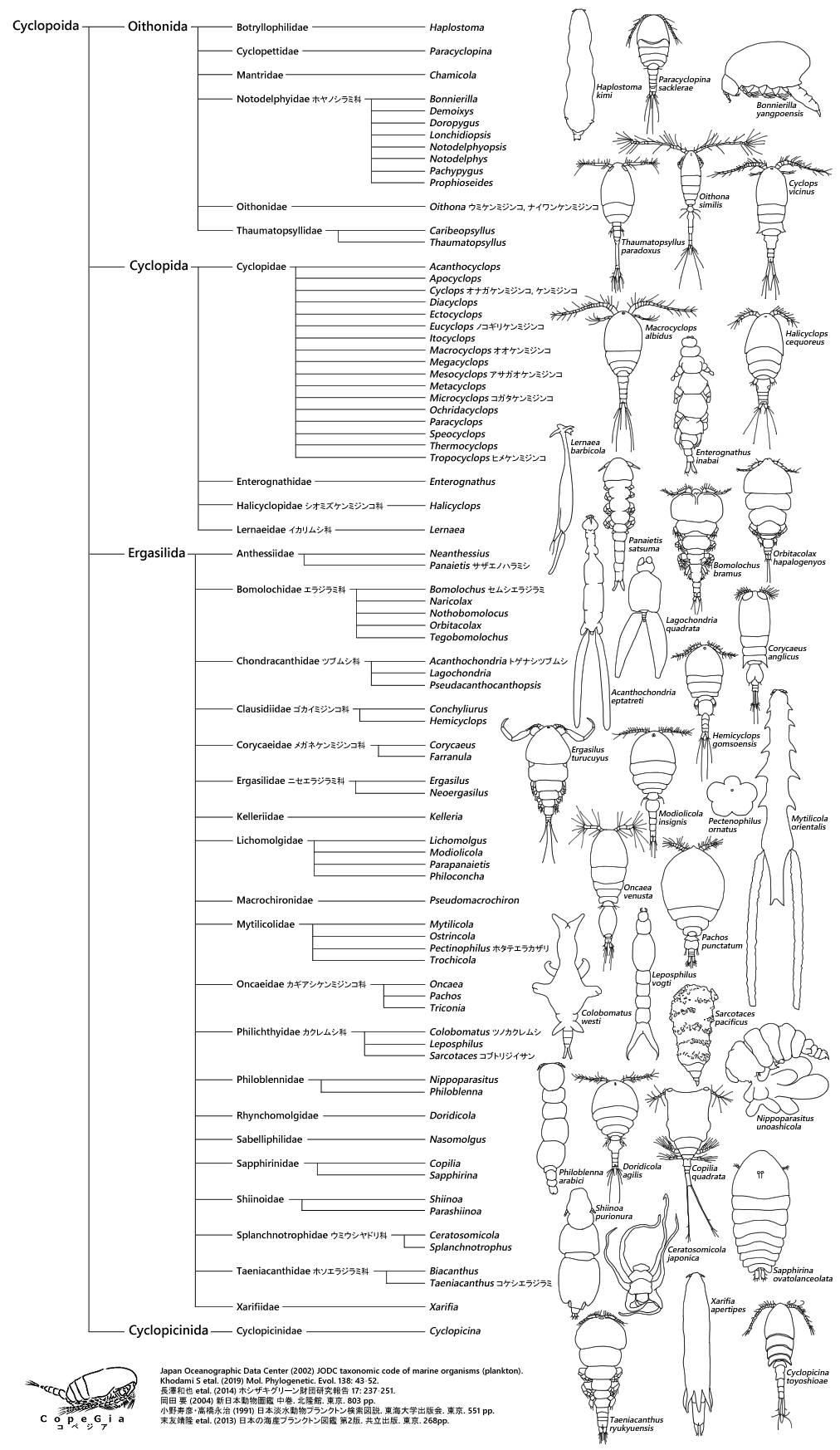カイアシ類キクロプス目の新分類(2020年)
*1 DOI: 10.1038/s41598-017-06656-4
*2 DOI: 10.1016/j.ympev.2019.106574
*3 DOI: 10.1101/650507
カイアシ類は、従来、
カイアシ類の下位分類は、Kohdami etal.(2017)とKhodami etal. (2019)が大きく貢献した。ここでは、キクロプス目下の新しい分類を紹介したい。
キクロプス目に属するカイアシ類は、池や湖などの陸水で普通に見ることができる。一般名として「ケンミジンコ」で知られる種だ。しかし、「ケンミジンコ」と呼べるカイアシ類はごく一部で、日本においては、Cyclopidae(ケンミジンコ科)とHalicyclopidae(シオミズケンミジンコ科)のみである。その他の多くのカイアシ類は「ケンミジンコ」と言い難い。金魚などの淡水魚を飼っていれば耳にするだろう、イカリムシ、あまり聞いたことはないだろうが、ホヤノシラミやエラジラミ、サフィリナもキクロプス目に属するカイアシ類である。浮遊性だけでなく、底生性、寄生性と多様な形態、種が含まれるのがキクロプス目だ。
そんなキクロプス目だが、Khodami etal. (2019)によって大きく分類は変わった。まず、キクロプス目は4つの亜目に大きく分かれた。Oithonida(オイトナ亜目)、Cyclopida(キクロプス亜目)、Ergasilida(エルガシルス亜目)、Cyclopicinida(キクロピシナ亜目)である(Fig. 1)。各亜目について説明する。
Oithonida(亜目)の多くは海洋性で、沿岸においては必ずと言っていいほどOithona属を見ることができる。日本ではOithona davisae、Oithona similisが普通種であろう。腹部が細長く、第1触角が長い特徴を持つ。Oithonidaの一部には寄生性の種も含まれる。代表種として、ホヤの体内に寄生するNotodelphyidae(ホヤノシラミ科)とヒトデの体内に寄生するThaumatopsyllidae(タウマトプシルス科)だ。
Thaumatopsyllidaeだが、ノープリウス幼生時期にヒトデに寄生し(Boxshall & Halsey 2004;Fosshagen 1970)、コペポディット幼体と成体は口器、消化管を欠くことから、当初、類似するモンストリラ目に分類されていたことがあった(Sars 1921)。モンストリラ目もノープリウス幼生で
Cyclopida(亜目)は、一般名としての「ケンミジンコ」と呼ばれるCyclopidae(科)とHalicyclopidae(科)が含まれる分類である。淡水魚に寄生するイカリムシ(Lernaeidae)がここに属する。
Cyclopidaの分子系統は生息域の進化を見ることができる。キクロプス目は海洋で派生した分類であるが、Cyclopidaは陸水(淡水)へ進化をした。沿岸種を含むOithonida(亜目)からEuryteidae(科)が派生し、まず汽水へ対応しHalicyclopidae(科)が派生する。そこから陸水に対応したLernaeidae(科)とCyclopidae(科)へ生息域を変化したという(Khodami etal. 2019)(Fig. 2)。

Ergasilida(亜目)は、ほとんどが寄生性である。もとはポエキロストム目に分類されていたグループである。宿主に同化してしまう寄生種や、度々、水柱へ泳ぎだすニーズな寄生種と様々である。形態も多様で、カイアシ類だとは思えない種は多い。Sarcotaces属とPectenophilus ornatusは、もはや動物だと、一見して思えないだろう。中には、光合成をするXarifia属や(参考記事 No. 11「共生藻を利用して光合成をするカイアシ類」)、
Cyclopicinida(亜目)は、1科1属3種しかない、極めて小さな分類である。外洋の海底に生息する。キクロプス目の中では、最も先祖に近い。本亜目の知見はとても乏しい。
文 献
Boxshall G A, Halsey S H (2004) An Introduction to Copepod Diversity Part II. The Ray Society, London. 966 pp.
Dahl E (1956) Some crustacean relationship. In: Bertil Hanström: Zoological Papers in Honour of His Sixty-fifth Birthday, 20th, 1956. pp 138-147. Lund Zoological Institute. Lund, Sweden. 311 pp.
Ferrari F D, von Vaupel Klein J C (2019) Rhabdomoplea, a new superorder for the thaumatopsyllioid copepods: the consequence of an alternative hypothesis of copepod phylogeny. Crustaceana 92 (2): 177-188.
Fosshagen A (1970) Thespesiopsyllus paradoxus (Sars) (Copepoda, Cyclopoida) from western Norway. Sarsia 42: 33-40.
Ho J S, Dojiri M, Hendler G, Deets G (2003) A new species of copepoda (Thaumatopsyllidae) symbiotic with a brittle star from California, U. S. A., and designation of a new order Thaumatopsylloida. J. Crust. Biol. 23: 582-594.
Hoshina T, Kuwabara R (1958) On a new parasitic copepod, Parapanaietis turbo n. sp. obtained from marine gastropod, Turbo stenogyrus Fischer. J. Tokyo Univ. Fish. 44 (1-2): 69-72.
Huys R, Boxshall G A (1991) Copepod Evolution. The Ray Society. London. 468 pp.
伊東 宏 (2006) プランクトンとして出現する寄生・共生性カイアシ類-サフィレラ型カイアシ類を中心に-. 日本プランクトン学会報 53 (1): 53-63.
Izawa K (1975) A new and a known Chondracanthid copepods parasitic on fishes from Tanabe Bay. Annotationes Zoologicae Japonenses 48 (2): 108-118.
Izawa K (1976) Two new parasitic copepods (Cyclopoida: Myicolidae) from Japanese gastropod molluscs. Publ. Seto Mar. Biol. Lab. 23 (3-5): 213-227
Izawa K (1976) A new parasitic copepod, Philoblenna arabici gen. et sp. Nov., from a Japanese gastropod, with proposal of a new family Philoblennidae (Cyclopoida: Poecilostoma). Publ. Seto Mar. Biol. Lab. 23 (229-235)
Izawa K (1976) A new parasitic copepod, Tegobomolocus nasicola gen. et sp. Nov. (Cyclopoida: Bomolochidae), from a Japanese goatfish. Publ. Seto Mar. Biol. Lab. 23 (3-5): 289-298.
Izawa K (1986) On the development of parasitic copepoda. IV. Ten species of poecilostome cyclopoids, Belonging to Taeniacanthidae, Tegomolochidae, Lichomolgidae, Philoblennidae, Myicolidae, and Chondracanthidae. Publ. Seto Mar. Biol. Lab. 31 (3-6): 81-162.
Izawa K (2009) Three new species of parasitic copepods (Copepoda, Cyclopoida, Shinoidae) infecting the Basal lamellae of Japanese actinopterygian fishes. Crustaceana 82 (9): 1119-1131.
Japan Oceanographic Data Center (2002) JODC taxonomic code of marine organisms (plankton). 2001 edition. In: Marine Organisms Data. 2020-4-25 accessed.
Kabata Z (1979) Parasitic copepoda of British-fishes. The Ray Society. London. 468 pp.
Khodami S, McArthur J V, Blanco-Bercial L, Arbizu P M (2017) Molecular phylogeny and revision of copepod orders (Crustacea: Copepoda). Sci. Rep. 7: 9164.
Khodami S, Mercado-Salas N F, Tang D, Arbizu P M (2019) Molecular evidence for the retention of the Thaumatopsyllidae in the order Cyclopoida (Copepoda) and establishment of four suborders and two families within the Cyclopoida. Mol. Phylogenetic. Evol. 138: 43-52.
Kudoh F, Nagasawa K (2017) Doridicola similis (Copepoda: Poecilostomatoida: Rhynchomolgidae) associated with Sepiteuthis sp. (Cephalopoda: Myopsida: Loliginidae), new to Japan. Spec. Divers. 22: 161-166.
長澤和也・片平浩孝・新田理人 (2014) 島根・鳥取県産魚類の寄生虫目録(1924-2014年). ホシザキグリーン財団研究報告 17: 237-251.
Nagasawa K (2015) A 2015 update and corrections to the checklist of the parasitic copepods of fishes and invertebrates of the Seto inland Sea, Japan. Biosphere Sci. 54: 113-124.
Ohtsuka S, Boxshall G A, Torigoe K (1976) A new genus and species of the family Mantridae (Copepoda: Cyclopoida) infecting the bivalve Pseudochama retroversa from the Seto Inland Sea, western Japan. J. Nat. His. 34: 1967-1976.
大塚 攻・田中隼人 (2020) 顎脚類(甲殻類)の分類と系統に関する研究の最近の動向. タクサ日本動物分類学会誌 48: 49-62.
岡田 要 (2004) 新日本動物圖鑑 中巻. 北隆館. 東京. 803 pp.
小野寿彦・高橋永治 (1991) 日本淡水動物プランクトン検索図説. 東海大学出版会. 東京. 551 pp.
Paschoal F, Nagasawa K,Luque J L (2016) A new species of Leposphilus Hesse, 1866 (Copepoda: Philichthyidae) parasitic in the interorbital canals of the whitemouth croaker Micropogonias fumieri (Desmarest) (Sciaenidae) off Brazil with an amended diagnosis of the genus. Syst. Parasitol. 93: 501-515.
Sars G O (1921) An account of the crustacea of Norway with short descriptions and figures of all the species. Vol. 8. Copepoda Monstrilloida & Notodelphyoida. Bergen Museum, Bergen Norway. 176 pp.
末友靖隆・松山幸彦・上田拓史・上野 俊士郎・久保田 信・鈴木紀毅・木元克典・佐野明子・副島美和・濱岡秀樹・中島篤巳 (2013) 日本の海産プランクトン図鑑 第2版. 共立出版. 東京. 268pp.
Swell R B S (1949) The littoral and semi-parasitic Cyclopoida, the Monstrilloida and Notodelphyoida. John Murray Expedition 1933-34. Sci. Rep. 9: 17-199.
Uyeno D, Ogasaka R, Nagasawa K (2016) Nippoparasitus unoashicola, a new genus and species of philoblennid copepod (Cyclopoida) parasitic on the Pacific sugar limpet, Patelloida saccharina (Linnaeus, 1758) (Patellogastropoda: Lottiidae) from the intertidal zone of eastern Japan. Zootaxa 4174: 386-395.
Yamaguti S (1939) Parasitic copepods from fishes of Japan. Part 4. Cyclopoida, II. Volume Jubilare pro Prof. Sadao Yoshida 2: 391-415.
Yamaguti S, Yamasu T (1959) Parasitic copepods from fishes of Japan with description of 26 new species and remarks on two known species. Biol. J. Okayama Univ. 5 (3-4): 89-165.
Walter T C, Boxshall G (2020) World of Copepods database. Cyclopoida. World Register of Marine Species. 2020-05-01 accessed.

